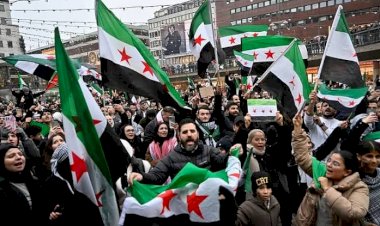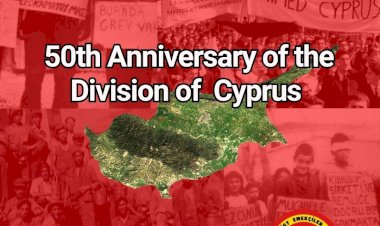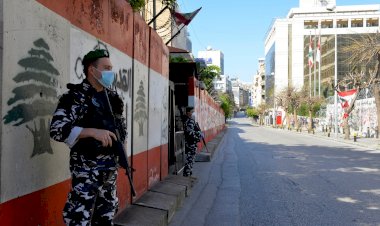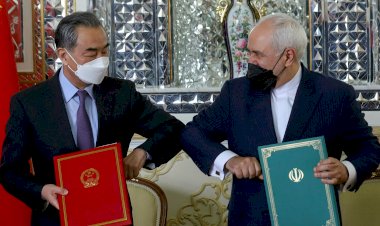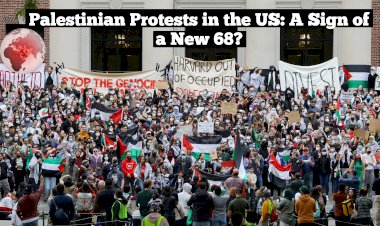The Class Based History of the Cyprus Problem
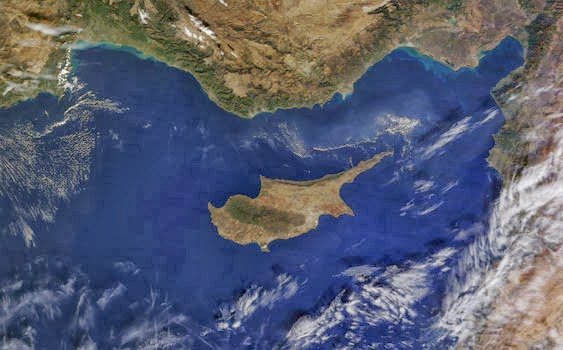
Celal Özkızan
“This is how the grandchildren of the Dratos, Smailos, Bizzitos, Gogoshis, Shonis and then; the Chilefuros, Bembeos, Gargarlis ended up in the lands where their grandfathers had made their home… Their grandfathers lived without religion, without nationality. They relied only on themselves… They did not seek a savior, they fought to save themselves… They held on to the lands where they grew up. But apparently, they could not take root. For this reason, their grandchildren sought a savior. They found one and were saved…”
Arif Hasan Tahsin – Nigose Baba
CLASS ORIGINS OF THE CYPRUS PROBLEM
The problem of Cyprus is one of the most “durable”, if not the most conflicting and bloody, of the problems we call the “national question” and specific to the age of capitalism. In Turkey, the Cyprus issue is generally discussed in the context of Turkey’s interests in Cyprus. Within Cyprus itself, both for the Turkish and Greek Cypriot people, the issue is seen as a problem that has arisen once and must be resolved in one way or another since. Even the nationalist political elites of both sides express their efforts to preserve the “current situation”, which largely serves their own interests, with the “jargon of solution”: For example, while the vast majority of the Turkish Cypriot nationalist wing, especially Denktaş, express that “the solution is in the absence of a solution”, the rest of the Greek Cypriot right, with the exception of the liberal DISI, has adopted “keeping the Republic of Cyprus alive, which has become a single-community state, as the “second best and, for now, the most realistic solution” (Kızılyürek, 2008: 180). So, as can be seen, not only those who are trying to transform the current division in Cyprus – in one way or another – but even those who benefit from the blessings of that division themselves, instead of describing the current situation itself as a “last resort”, are seeking a “solution” that will finalize and perpetuate the current situation. In other words, both in the north and south of this small island fragment, even a concept that codes the current situation such as the "survival of the state", is perceived as something that needs to be "built" rather than maintained. The Cyprus problem constitutes a very dynamic ground that pushes even those who feed off the current situation to seek a "solution". So, what is the Cyprus problem? What is the "problem" in the Cyprus problem?
Leaving aside the historical aspect of the issue, looking directly at the negotiation table and the diplomatic war between the parties, roughly speaking,
“It is a fact that the negotiations ongoing in Cyprus today are based on the principle of “Land for Equality” (political equality in exchange of land), even if it is not named. The main subject of negotiations held between the Greek Cypriot community holding the Republic of Cyprus founded on the basis of political equality and the Turkish side which seized 37% of the island’s land in 1974, is the principle of “participation in state bodies on the basis of political equality in exchange for land”. While the Greek Cypriot side emphasizes the demilitarization of the island in addition to its demands on land and property, the Turkish side wants the principle of political equality to be implemented in a way that will cover all areas of life.” (Kızılyürek, 2009 : 9)
On the other hand, even though the current arrangement and distribution of the cards on the Cyprus negotiation table is like this, only thing to be kept in mind is that the fact that Cyprus problem manifests itself in this way today does not mean that Cyprus problem is limited to this:
“The Cyprus problem, what the problem in Cyprus is or what is a problem in Cyprus, has different contents for each subject inside and outside. Furthermore, each subject’s own definition of the problem is not fixed; it changes according to historical periods and various political, economic and strategic reasons. For example, for the Hellenic Cypriots, the Cyprus problem was for a long time the problem of the right to join Greece (enosis) not being recognized. However, although there is still a very small group of Greek nationalists who have such a goal, for the Greek Cypriot people, the problem’s definition has now changed to Turkey’s military presence on the island and the population transfer (Turkish occupation). The content of the problems of all other subjects such as the Turkish Cypriots, Greece, Turkey, the USA, the United Kingdom etc. regarding Cyprus can change historically, just like in the example above, and the problems of each subject are different from each other. The conclusion that emerges from this is very clear: In truth, there is no single Cyprus problem. Each subject with an interest in the island has a different problem and each subject is trying to solve their own problem.” (Rahvancıoğlu, 2012)
Starting from this point, we can say that the current manifestation of the Cyprus problem is the point that the dynamic and sometimes contradictory and sometimes overlapping struggle of various subjects who look at Cyprus from their own window has reached - for now. On the other hand, if we accept class relations and class struggles as the basic perspective in making sense of - and transforming - societies, examining the class roots of the Cyprus problem will help us both understand "how" and "why" this problem came to this point; and also save ourselves from the mistake of accepting the current stop of the Cyprus problem as the "main station", revealing the will to turn the train to a direction based on class struggle.
***
Those who are somewhat familiar with the history of Cyprus and the Cyprus problem are certainly aware of the ethnic tensions in the recent history of Cyprus, the nationalist confrontations and the international dynamics that emerged due to the key importance of Cyprus in the context of the Cold War. However, very few subjects -including Cypriots- have seriously considered and made a detailed examination of the class roots and content of the Cyprus problem, making this their compass. Of course, it is not possible to fulfill such a goal in a complete manner in this article. However, I will at least try to convey the main lines and sometimes important details that can form the basis of such an examination.
Cyprus was an Ottoman colony until 1878 and, like many other geographies within Ottoman territory, was subject to “Ottoman-style feudalist” relations. The Ottomans granted the Orthodox Church in Cyprus the same privileges, be it administratively, be it managerial and be it economically, as they granted to their own “non-Muslim” subjects. As such, the Orthodox Church in Cyprus flourished as a “political-economic power” during the Ottoman period. Moreover, the Ottoman administration repeatedly cooperated with the Orthodox Church in Cyprus to suppress rebellions of the 'serfs,' the feudal peasants, in Cyprus, whether Muslim or Orthodox, primarily due to heavy taxation. In short, if we simplify the “class alignment” between 1571 and 1878, the following picture emerges: on the one hand, the alliance between the Ottoman Empire and its military and administrative representatives in Cyprus and the Orthodox Church in Cyprus; on the other hand, the poor - and overwhelmingly peasant - ‘subjects’ of Cyprus, both Muslims and Orthodox.
In 1878, the Ottomans leased the island of Cyprus to Britain, which would later annex the island completely in 1914. Britain’s arrival on the island was a turning point in social and productive relations. When Horatio Kitchener, a British commander who had also made observations on Cyprus, conducted “the first comprehensive land survey of the island” after the British had captured the island, he came to the following conclusion: “There were many places on the island that were waiting only for the hand of a capitalist to transform them from barren desolation into their former fertile states” (Morgan, 2013 : 24). Britain, which had its eye on Cyprus largely due to its strategic location and was not worth serious ‘treatment’ in terms of either labor, market or underground resources, perhaps did not see it as an Indian colony; but it had no intention of sitting idle either:
“The British tried to make Cyprus a market where they could sell their products by changing regulations to rationalize various parts of the administration and by encouraging the development of certain industrial sectors, especially mining (…) In this way, a small proto-industrial sector operating on a capitalist basis emerged in Cyprus (…) The laissez-faire administration of the British in Cyprus, new economic relations (…) The most important financial reform of the British was the abolition of social responsibilities for tax payments in the mid-1880s, so that tax payment became an individual obligation. This change introduced individual property so effectively that owners could manage their property in terms of conveyance and mortgage. This change also meant that the poorest and least enterprising individuals were exposed to the risk of getting into debt and losing their property. In 1885, the British introduced a law on the compulsory sale of land, radically changing the Ottoman practice of prohibiting moneylenders from selling peasants’ property.” (Katsurides, 2014: 50-52)
Moreover, the British colonialists,
“... soon managed to penetrate every corner of the island. They issued documents to peasants that they couldn’t read, declaring that they owned plots of land that they might not be able to cultivate. The subjects of an empire were suddenly transformed into legal, tax-paying members of a bureaucracy, and they soon learned that ‘equal rights’ also meant ‘equal injustices.’” (Bryant, 2002: 38-39)
As these vivid narratives also show, the British control of the island triggered a transformation of production relations in particular and social relations in general on a capitalist basis. The consequences of this in terms of classes were as follows: First of all, as in many other geographies of the Ottoman Empire, those who largely controlled trade in Cyprus were the ‘non-Muslims’, that is, Orthodox merchants; and again, the commercial accumulation of Orthodox merchants in Cyprus during the Ottoman period, just as in the case of the ‘non-Muslim’ merchants in Anatolia, would lead to the transformation of the owners of this accumulation into the core of a modern bourgeois class in the context of capitalist transformation. On the other hand, the Muslim elites left over from the Ottoman Empire in Cyprus did not have the opportunity to transform into a modern bourgeois class, since they mostly assumed military and administrative functions during the Ottoman period. This was one of the fundamental class consequences of the British colony for those ‘at the top’, and it was precisely this dynamic that formed the basis for Enosis, the policy of the Greek Cypriot commercial bourgeoisie and the Church to connect Cyprus to Greece.
Of course, this transformation did not occur in such a linear manner. For example, as the Church lost its “feudal privileges” due to the social relations that transformed with the British colony, it also entered into a conflict with the British colony; naturally, the process of the Greek Cypriot merchants, who had almost organic ties with the Church, becoming bourgeois was not smooth. Unfortunately, it will not be possible to discuss this issue in depth ,which could be the subject of a separate article, in this article. However, it should be noted that the reasons why the emerging Greek Cypriot bourgeoisie pursued a policy of annexation to Greece instead of raising an independence struggle like many other “national bourgeoisies” can be sought in, in addition to many historical and cultural factors, in the fact that the Greek Cypriot bourgeoisie was primarily composed of merchant capital and therefore, instead of establishing dominance in the domestic market, it determined its primary goal to connect to world markets through unification with Greece. The fact that a significant number of Greek Cypriot merchants lived abroad is another factor. Later, in the 1950s and especially in the 1960s, with the development of the industrial bourgeoisie within the Greek Cypriot bourgeoisie, the serious development of the internal market in Cyprus and Cyprus becoming an important touristic location, the demand for union with Greece - although it maintained its weight in the discourse of Greek Cypriot bourgeois politics - was gradually replaced by a policy centred on Cyprus.
On the other hand, for the reasons mentioned above, the Muslim elites on the island could not go through the same transformation. As such, on the one hand, a community that had transformed from a religious Orthodox community into a modern “Hellenic Cypriot society” with a developing bourgeoisie and working class and a national identity whose construction was accelerated by the demand for Enosis; on the other hand, the Turkish Cypriot community, whose “serfs” had now become “proletarians” but whose military and administrative “lords” of the past had never become bourgeois. Since it is important to clearly emphasize how striking this differentiation was, let us not hesitate to quote the following long passage:
In 1962, Greek Cypriots constituted 80% of the island’s population, while Turkish Cypriots constituted 18% (…) 79.3% of individual land ownership belongs to Greek Cypriots, 20.7% to Turkish Cypriots, but the share of Turkish Cypriots in agricultural production is 12.6%. 81.7% of real estate income belongs to Greek Cypriots, 17.5% to Turkish Cypriots. Of firms employing more than 5 workers, 99.4% belong to Greek Cypriots, 0.06% to Turkish Cypriots, 96.6% of action companies belong to Greek Cypriots, 3.4% to Turkish Cypriots, and 94.1% of the state’s income tax is paid by Greek Cypriots and 5.9% by Turkish Cypriots. 57.5% of exports are made by Greek Cypriots, 35.8% by Greek Cypriots living abroad, 6.4% by Armenians and only 0.03% by Turkish Cypriots. The share of Greek Cypriots in imports is 78.7%, 12.8% by Greek Cypriots living abroad, 5.3% by Armenians and only 3.2% by Turkish Cypriots. The contribution of Turkish Cypriots to the GNP is 7.5% against 18% of the population. 86.1% of doctors, 81.3% of dentists and 91.6% of pharmacists are Greek Cypriots. The share of Turkish Cypriots in agricultural production is 12.6%, 10% in citrus fruits, 6.2% in industry and only 6.1% in electricity production (which is an indicator of welfare).” (Beratlı, 2012 : 48)
This being the case, on the one hand, the Greek Cypriot bourgeois politics that made no attempt to include the Turkish Cypriots in a common national liberation struggle against the British colonial power, and even aroused serious security and future concerns in the Turkish Cypriots with the demand for Enosis; on the other hand, the Turkish Cypriot upper class led by Denktaş, who were gradually losing the dominant position they once held during the Ottoman period and pursued a nationalist and separatist policy due to the fear of losing the Cyprus market entirely to the Greek Cypriot bourgeoisie caused by economic backwardness, were the basic elements that brought the famous ‘Taksim’(division) policy to the agenda. Cypriot Turkish upper class, with the very serious encouragement of Britain that we can’t get into here, put forward their own nationalist project in opposition to Enosis, Taksim, that is: the division of the island into two leaving one part to Greece and the other to Turkey. At the roots of this policy was the ideal of the Turkish Cypriot upper class to create their own separate market, or to use the jargon of the subject in question correctly, a “Turkish bazaar.” Let us hear this ideal from Rauf Denktaş himself:
“When I was very young, I would hear people like my father Hikmet Raif, “Söz” newspaper owner Remzi Okan and Con Rıfat, lawyer Fadıl Bey talking about this issue saying: “Why don’t we follow the path of protecting our own nation like the Armenians and the Greeks?” and getting upset. (…) The entire market, with its imports and exports, is in the hands of the Greeks: Turks only buy from Greeks on credit and sell to Turks on credit. The Greeks were constantly expanding in the economic field, while we were raising a new retailer, a new grocer or merchant in a very new neighborhood. This situation continued for years and will surely continue.” (Kızılyürek, 2011: 68)
***
As seen above, when we look at the class origins of the slew of problems appearing as “ethnic division” and manifesting as “Cyprus Problem”; we see two different bourgeois projects, a socialization dynamic that capitalism channels into two different channels and ultimately, two different hegemony projects called Enosis and Taksim. Of course, the history of Cyprus’ division is not limited to this. In Cold War’s context, in a region like Cyprus that was both strategically important and perception of the “threat” of communism was strong, influence of external actors, large and small, primarily the US, Britain, Turkey and Greece, played major roles in shaping the recent history of Cyprus. Moreover, in the recent history of Cyprus, there are not only “foreign powers” or “local bourgeoisie” but also processes and actors such as a strong working-class struggle and the Communist Party of Cyprus that left behind an enormous theoretical/practical accumulation in its early – and short – life. However, in this article, I have tried to focus on only one particular aspect of the issue. Again, when we come to the present day, the Turkish Cypriot and Greek Cypriot bourgeoisies are now in favor of the reunification of Cyprus, a common federal state and a political solution to the Cyprus problem. What has changed from those days to the present is, again, the subject of a completely different article.
REFERENCES
Arslan, H. (2014). The Political Economy of State-Building : The Case of Turkish Cypriots (1960-1967) (Yayınlanmamış doktora tezi). I
stanbul Bilgi University.
Beratlı, N. (2012). Kıbrıs’ta Ulusal Sorun. Khora.
Bryant, R. (2002). Tebaadan Vatandaşa : Kıbrıs’ta Modernite ve Milliyetçilik. İletişim.
Katsurides, Y. (2014). Kıbrıs Komünist Partisi Tarihi : Sömürgecilik, Sınıf ve Kıbrıs Solu. Kalkedon.
Kızılyürek, N. (2008). Tarih, Siyaset, Kıbrıs. Yenidüzen kitapları.
Kızılyürek, N. (2009). “Daha önceleri neredeydiniz?” : Dünden bugüne Kıbrıs müzakereleri. Birikim.
Kızılyürek, N. (2011). Paşalar Papazlar : Kıbrıs ve Hegemonya (2. baskı). Khora.
Morgan, T. (2013). İngilizlerin Kıbrıs’taki Tarihi : Acısıyla Tatlısıyla Bir Ada. Khora.
Rahvancığolu, M. (2012, Mayıs 15). Kıbrıs Komplosu Kitabının Türkçe Baskısına Önsöz. Ocak 27, 2017 tarihinde http://rahvancioglu.blogspot.com.cy/2012/05/kbrs-komplosu-kitabnn-turkce-basksna.html sitesinden alındı.



